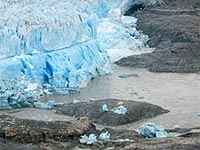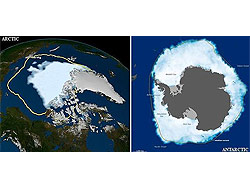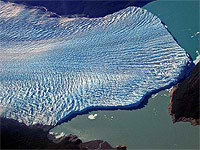Así lo confirmó ayer el director general de Aguas, Rodrigo Weisner, al señalar que sobrevolarán el área, que incluye al río Baker, el Lago Colonia y el glaciar Colonia.
A un año de la desaparición del lago Témpano, el Cachet 2, situado en el sector oriental de Campo de Hielo Norte, de cinco kilómetros de largo y uno de ancho se vació aparentemente por las altas temperaturas registradas en la zona.
La situación se descubrió el pasado 7 de abril, cuando expertos observaron un fuerte aumento en el caudal del río Baker, que pasó de los mil 200 metros cúbicos por segundo hasta un máximo de tres mil 570 metros cúbicos por segundo, en un periodo de 48 horas.
El fenómeno significó un aumento temporal de 4.5 metros en el nivel del río, mientras que la temperatura del mismo disminuyó en ese periodo de ocho a cuatro grados centígrados.
“La disminución de temperatura en el río Baker hace pensar que el fenómeno tuvo su origen en la rotura de alguna estructura glacial cercana a la vertiente oriental de Campo de Hielo Norte”, indicó Weisner.
El funcionario dijo que tras el “vaciado” del lago no hay víctimas ni heridos y el caudal del agua ha comenzado a disminuir paulatinamente, por lo que esperan que pronto llegue a su normalidad.
Noticia publicada en Milenio (México)
Enlaces a sitios |
| |
Climbing Magazine Climbing Magazine"s Web site contains more than 30 years of rock and ice climbing news, climber profiles, technical information, and gear reviews. You"ll also find message boards, photo galleries, and classifieds
| Cold Regions Bibliography Between 1999 and 2000, this project was carried out under an Interagency Agreement between the Federal Research Division of the Library of Congress and the U.S. Army Cold Regions Research and Engineering Laboratory (CRREL).
|
Descent into the Ice A tem of "glacionauts" ventures into a labyrinth of unexplored anda hazardous glacier caves on France"s Mont Blanc
| Glacier and Permafrost Hazards in Mountains – GAPHAZ Scientific Working Group of the International Association of Cryospheric Sciences (IACS) and the International Permafrost Association (IPA). Department of Geosciences University of Oslo
|
Glacier hazards The experience and data on glacier disasters in Switzerland has been systematically collected in the past two decades, and historical sources were analyzed.
| Glacier Hazards From Space Glacier hazards represent a continuous threat to human lives and infrastructure in mountain regions.
|
Glacier Hazards in Perú The floods, known in Perú as aluviónes, come with little or no warning and are composed of liquid mud that generally transports large rock boulders and blocks of ice.
| Glaciers and Glacier Hazards Glaciers and Glacier Hazards Glaciers and Ice Sheets and Volcanic Eruptions, USGS/Cascades Volcano Observatory, Vancouver, Washington
|
Glaciers online Glaciers online offers photos and summary explanations concerning glaciers from all over the world. The primary goal of our project is to enrich and stimulate the teaching of Earth Science and Physical Geography, in particular glaciology.. Jürg Alean & Mi
| Global Land Ice Measurements from Space GLIMS (Global Land Ice Measurements from Space) is a project designed to monitor the world"s glaciers primarily using data from optical satellite instruments, such as ASTER (Advanced Spaceborne Thermal Emission and reflection Radiometer).
|











 Imagen: Agencia AP
Imagen: Agencia AP





